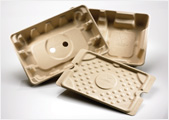Dell has been leading on using sustainable packaging for its computers and other products, and today announced a goal to achieve a waste-free packaging stream by 2020.
It will do that in two ways:
- 100% of packaging will be sourced from sustainable materials, including recycled and rapidly renewable content, or material that was formerly part of the waste stream
- 100% of packaging will be either easily recyclable or compostable at the end of its life.
More than half of Dell’s packaging already meets the criteria.
"Packaging is often the first part of our products that customers see and touch. From that first interaction, we want to ensure our customers know we’re dedicated to operating in an environmentally responsible manner, and we want to make it easier for them to be sustainable as well," says Trisa Thompson, vice president of corporate responsibility for Dell.
For notebooks made in China, Dell will use wheat straw packaging for cardboard boxes, which is currently burned by many Chinese farmers because they don’t see a use for the agricultural waste. That contributes to air pollution and associated health issues there, which has become a huge problem.
The boxes will look and perform like regular cardboard and can be recycled the same way.
This August, Dell will start mixing it with recycled cardboard, ramping it up until its all wheatstraw. It will be sourced from farmers in Jiangsu Province, cutting their carbon emissions. An enzymatic process will be used to pulp the wheatstraw, modeled on the way cows digest grass – the process cuts energy use by 40% and water by almost 90% in comparison to chemical pulping.
Other innovative materials Dell has been using include bamboo cushions that replace foam for shipping light products like notebooks and mushroom packaging to replace foam for heavier products such as servers. Both materials are recyclable or compostable.

Dell explains the process of making mushroom packaging, made by Ecovative Design:
"Waste products like cotton hulls are placed in a mold which is then inoculated with mushroom spawn. Our cushions take 5-10 days to grow as the spawn, which become the root structure – or by the scientific name, mycelium – of the mushroom. All the energy needed to form the cushion is supplied by the carbohydrates and sugars in the agricultural waste. There’s no need for energy based on carbon or nuclear fuels."
As of last year, Dell cut the size of packaging by 12%, increased the amount of recycled and renewable content by 40% and met its goal of ensuring that 75% of packaging can be recycled at the curb. This work eliminated more than 20 million pounds of packaging material and saved $18 million since 2008.
The company takes a lifecycle approach to sustainability that includes using smarter materials, energy efficiency, environmental standards and easy recycling.
Unfortunately, it’s also a big at offshoring jobs. As of 2011, it made most of its computers abroad, cut 7,300 jobs in the US while creating 4,300 jobs overseas. It was named the Greenest Company in America by Newsweek in 2010.

That is really a good news in packaging industry. Thank you for the important information.